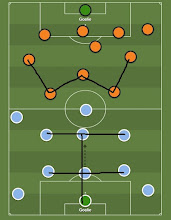A few notable figures in Copa America history were able to win the title as
players and managers.
Copa America 2024 has been underway. The reigning champions, Argentina, did
not have much difficulty securing a win over Canada at the opener. Lionel Messi
is aiming to lift the trophy for the second time, and so is his boss, Lionel
Scaloni. Unfortunately, he never had a chance to do the same as a player. The
former Lazio man never received a call-up for the regional tournament during
his playing years.
He is not as fortunate as these notable names who have won silverware as
players and managers. One of them was even a World Cup winner while he was
still actively playing in the 1990s.
Lais (Brasil)
The Brazilian midfielder was one of the few successful player-managers in
South America. In Copa America 1922, he clinched the title with such a role.
Brazil was the host and unbeaten throughout the championship. Lais’ men were
held three times before finally dismantling Argentina 2-0. They had to face off
against Paraguay in the playoff final, as both shared the same points. Before
1922, he also took part in the 1919 edition, when Selecao also won the
silverware.
Americo Tesoriere (Argentina)
The former goalkeeper was the key player in Argentina’s victory in the South
American Championship in 1921. It was the first title for Albiceleste.
Tesoriere was even instrumental in their success, as Argentina went unbeaten
and did not concede a single goal throughout the competition. Four years later,
the former Boca Juniors man was at the helm of the team. The 1925 edition was
the only one with the fewest contestants—only three teams: Argentina, Brazil,
and Paraguay. He led Manuel Seoane and Co. to secure three wins and one draw
and snatch their second title.
Manuel Seoane (Argentina)
The Argentine striker was the earliest to win the Copa America as a player
and a manager. He was part of the winning squad in the 1925, 1927 and 1929 editions.
In 1925, he was even named the top scorer by netting six times in the
competition, whereas in 1929, Seoane only played one game.
Meanwhile, in the 1937 edition, he brought Albiceleste to lift another
trophy when he was in the dugout. The former Independente man guided them to
beat Brazil 2-0 in the playoff final. At that time, Copa America was still
using the round-robin format. They shared the same points as Selecao after
collecting four wins and one loss. The champions had to be decided by a
playoff.
Pedro Cea (Uruguay)
He was
Uruguay’s star in the 1920s and 1930s. Cea was the key man in La Celeste when
they won a number of prestigious silverwares, including the Copa America in
1923 and 1924 consecutively, gold medals in the 1924 and 1928 Summer Olympics,
and the 1930 FIFA World Cup. The former Nacional Montevidio man bagged five goals in the World Cup’s first edition, including a hattrick in the semifinal while hammering Yugoslavia 6-1.
After he
hung his boots, Cea was named the manager of La Celeste in the early 1940s. He
was able to bring Luis Castro and Co. to lift the trophy in the Copa America
1942. The ex-striker took full advantage of being the host by winning all the
matches, scoring the most goals, and conceding the least in the championship.
They toppled their fiercest contender, Argentina, which was only two points
adrift on the table.
Danilo Alvim (Brasil)
He was
one of the 1950 FIFA World Cup member squads that was more notorious for their
humiliating failure in the Maracana final than their actual talents. Danilo was
a defensive midfielder well-known for his elegance in controlling the game from
the second line and his dangerous long pass.
Prior to
the 1950 World Cup, he, alongside Ademir, Jair, and Zizinho, became an integral
part of Brazil’s success in winning the Copa America in 1949. They clinched the
title with a perfect record, scoring the most goals, securing wins in all
matches, and trashing Paraguay in the playoff final. The only flaw in that
edition was the absence of their archrival, Argentina, which decided to
withdraw from the competition.
Danilo
then continued his career as a manager once he retired by taking charge of
minnows such as Remo, Uberaba, Nautico, and Galicia, plus his former club,
Botafogo. Unfortunately, none of his spells at the club ended with notable
silverware. On the contrary, he snatched a huge as well as unexpected victory
while at the helm of Bolivia, as he guided them to snatch their only Copa America title in 1963. His team took all the advantage as a host by staging their game
in La Paz, one of the highest cities in the world located
at 3600 km above the sea level, to defeat the best teams in the continent, Argentina, 3-2, and
Danilo’s own nation, Brazil, 5-4, respectively.
Dunga (Brasil)
He is the
last winning manager who also won the title as a player. Dunga not only lifted
the trophy once but twice as a player, in 1989 and 1997. He was already the
first choice in both editions. In fact, he was the skipper in the latter
edition. The former VfB Stuttgart and Fiorentina man contributed more in
Bolivia 1997, as he also scored one goal and provided one assist in the
competition.
Meanwhile, as
a manager, the former defensive midfielder clinched the title in his tournament
debut in 2007. Dani Alves and Co. were able to dismantle Argentina with Lionel
Messi, Roman Riquelme, and Carlos Tevez in the squad by three goals to nil.
Unfortunately, he could not replicate his own success in his second stint.
Dunga’s Selecao had a dismal result in 2015 and 2016 by heading to an early
exit, especially in the latter edition, the Copa America Centenario in the USA.
Sadly, it was his very last time in the dugout.



Comments
Post a Comment